
The Battle of Leipzig ; Swedish: Slaget vid Leipzig), also known as the Battle of the Nations, was fought from 16 to 19 October 1813 at Leipzig, Saxony. The Coalition armies of Austria, Prussia, Sweden, and Russia, led by Tsar Alexander I and Karl von Schwarzenberg, decisively defeated the Grande Armée of French Emperor Napoleon Bonaparte. Napoleon's army also contained Polish and Italian troops, as well as Germans from the Confederation of the Rhine. The battle was the culmination of the German Campaign of 1813 and involved 560,000 soldiers, 2,200 artillery pieces, the expenditure of 400,000 rounds of artillery ammunition, and 133,000 casualties, making it the largest battle in Europe prior to World War I.

The 92nd Infantry Division was an African-American infantry division of the United States Army that served in both World War I and World War II. The military was then segregated. The division was organized in October 1917, after the U.S. entry into World War I, at Camp Funston, Kansas, with African-American soldiers from all states. In 1918, before leaving for France, the American buffalo was selected as the divisional insignia due to the "Buffalo Soldiers" nickname, given to African-American cavalrymen in the 19th century. The divisional nickname, "Buffalo Soldiers Division", was inherited from the 366th Infantry, one of the first units organized in the division.

The 1st Mountain Division was an elite formation of the German Wehrmacht during World War II, and is remembered for its involvement in multiple large-scale war crimes. It was created on 9 April 1938 in Garmisch Partenkirchen from the Mountain Brigade which was itself formed on 1 June 1935. The division consisted mainly of Bavarians and some Austrians.

John Robert Fox was a United States Army first lieutenant who was killed in action after calling in artillery fire on the enemy during World War II. In 1997, he was posthumously awarded the Medal of Honor, the nation's highest military decoration for valor, for his actions on December 26, 1944, in the vicinity of Sommocolonia, Italy. It is believed that he called in his own coordinates because he was in an area overran with German soldiers.

The 1st Cossack Cavalry Division was a Russian Cossack division of the German Army that served during World War II. It was created on the Eastern Front mostly out of Don Cossacks already serving in the Wehrmacht, those who escaped from the advancing Red Army and Soviet POWs. In 1944, the division was transferred to the Waffen SS, becoming part of the XV SS Cossack Cavalry Corps, established in February 1945. At the end of the war, the unit ceased to exist.
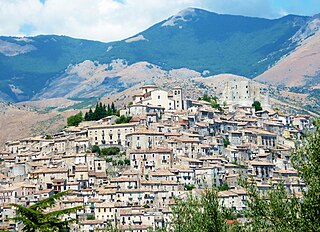
The Battle of Campo Tenese saw two divisions of the Imperial French Army of Naples led by Jean Reynier attack the left wing of the Royal Neapolitan Army under Roger de Damas. Though the defenders were protected by field fortifications, a French frontal attack combined with a turning movement rapidly overran the position and routed the Neapolitans with heavy losses. The action occurred at Campotenese, a little mountain village in the municipality of Morano Calabro in the north of Calabria. The battle was fought during the War of the Third Coalition, part of the Napoleonic Wars.

The 19th Infantry Division "Venezia" was a infantry division of the Royal Italian Army during World War II. The Venezia was classified as a mountain infantry division, which meant that the division's artillery was moved by pack mules instead of the horse-drawn carriages of line infantry divisions. Italy's real mountain warfare divisions were the six alpine divisions manned by Alpini mountain troops. The division was named for the city of Venice and based in Tuscany, from where it also recruited most of its troops. After the Armistice of Cassibile between the Allies and Italy was announced on 8 September 1943 the division joined the Yugoslav partisans in Montenegro and formed the Partisan Division "Garibaldi".

The 369th (Croatian) Reinforced Infantry Regiment was a regiment of the German Army raised to fight on the Eastern Front during World War II. The regiment was formed in July 1941 by Croatian volunteers from the Independent State of Croatia (NDH), including a Bosnian Muslim battalion. It was commonly referred to as the Croatian Legion. The troops swore a joint oath of allegiance to the Führer, the Poglavnik, the German Reich and the NDH. The unit was sent to the Russian front where it was attached to the 100th Jäger Division. In 1943, as part of the 6th Army, it was the only non-German unit to participate in the battle of Stalingrad where it was virtually destroyed. On 31 January 1943, the 800 surviving Croatian legionaries, led by their commander Marko Mesić, surrendered to the Red Army.
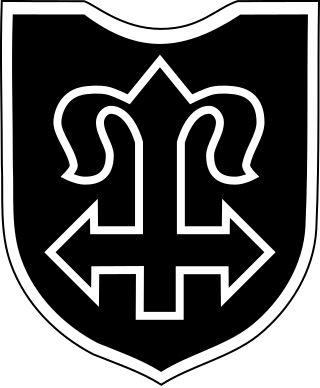
The 24th Waffen Mountain Division of the SS "Karstjäger" was a German mountain infantry division of the Waffen-SS, the armed wing of the German Nazi Party that served alongside, but was never formally part of, the Wehrmacht during World War II. At the post-war Nuremberg trials, the Waffen-SS was declared to be a criminal organisation due to its major involvement in war crimes and crimes against humanity. Named Karstjäger, the formation was one of the 38 divisions fielded by the Waffen-SS. Formed on 18 July 1944 from the SS Volunteer Karstwehr Battalion, its nominal strength was never more than theoretical and the division was soon reduced to the Waffen Mountain (Karstjäger) Brigade of the SS. Throughout its existence as a battalion, division and brigade, it was primarily involved in fighting partisans in the Karst Plateau on the frontiers of Yugoslavia, Italy, and Austria; the mountainous terrain required specialised mountain troops and equipment.

117th Jäger Division was a German infantry division of World War II. The division was formed in April 1943 by the reorganization and redesignation of the 717th Infantry Division. The 717th Division had been formed in April 1941. It was transferred to Yugoslavia in May 1941, to conduct anti partisan and Internal security operations.

The 392nd (Croatian) Infantry Division was a so-called "legionnaire" division of the German Army during World War II. It was formed in August 1943 using Croatian Home Guard soldiers with a German cadre. The division was commanded by Germans down to battalion and even company level in nearly all cases. Originally formed with the intention of service on the Eastern Front, this did not eventuate, and the division was used in anti-Partisan operations in the territory of the Independent State of Croatia (NDH) until the end of the war. It was commonly known as the Blue Division.
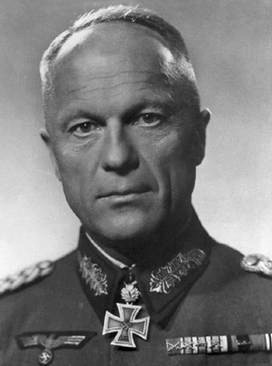
Johann Mickl was an Austrian-born army officer and division commander who served Nazi Germany during World War II. Reaching the rank of general (Generalleutnant), he was one of only 882 recipients of the Knight's Cross of the Iron Cross with Oak Leaves. He was commissioned shortly before the outbreak of World War I, and served with Austro-Hungarian forces on the Eastern and Italian Fronts as a junior officer in the Imperial-Royal Mountain Troops. During World War I he was decorated several times for bravery and leadership and was wounded on four occasions.

The 369th (Croatian) Infantry Division was a legionary division of the German Army (Wehrmacht) during World War II.

The Battle of Garfagnana, known to the Germans as Operation Winter Storm and nicknamed the "Christmas Offensive", was a successful Axis offensive against American forces on the western sector of the Gothic Line during World War II. It took place in December 1944 in the north Tuscan Apennines, near Massa and Lucca.
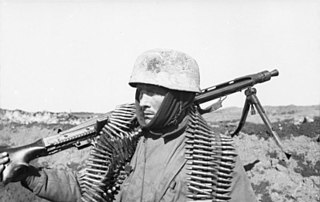
The Fallschirmjäger were the paratrooper branch of the German Luftwaffe before and during World War II. They were the first German paratroopers to be committed in large-scale airborne operations. Throughout World War II, the commander of the branch was Kurt Student.

The 373rd (Croatian) Infantry Division was a division of the German Army during World War II. It was formed in June 1943 using a brigade from the Home Guard of the Independent State of Croatia with the addition of a German cadre. The division was commanded by Germans down to battalion and even company level in nearly all cases, and was commonly referred to as a "legionnaire division". Originally formed with the intention of service on the Eastern Front, it was used instead for anti-Partisan operations in the territory of the NDH until the end of the war. It fought mainly in the western areas of the NDH, and was involved in the attempt to kill or capture the leader of the Partisans, Josip Broz Tito, in May 1944. Severely depleted by desertion, the division withdrew towards the Reich border in the early months of 1945, eventually surrendering to the Partisans on 10 May 1945 near Brežice in modern-day Slovenia.
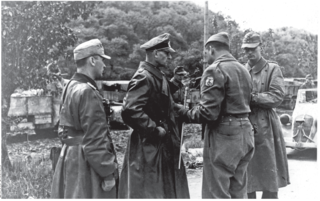
The Battle of Collecchio-Fornovo was a battle of the Second World War between the Brazilian Expeditionary Force, along with Italian partisans and units from the American 1st Armored and 92nd Infantry Divisions, against the Wehrmacht's 148th Infantry Division, 90th Panzergrenadier Divisions and the fascist National Republican Army's 1st Bersaglieri "Italia" and the 4th Mountain "Monterosa" Divisions. The battle was fought around the town of Fornovo di Taro, about 8 miles (13 km) to the southwest of Parma, Italy. The Allies defeated the Axis forces, which were attempting to break through to the north.

The battle of Knin was a major Yugoslav Partisan operation during World War II in Yugoslavia launched by the 8th Dalmatian Corps from 7 November to 9 December 1944 with the purpose of destroying German, Ustaše and Chetnik formations in North Dalmatia and the city of Knin, then part of the Independent State of Croatia. It was the final part of the 8th Corps offensive for the liberation of Dalmatia which began on 12 September 1944. The Knin operation had three phases: Initial battles on approaches to Knin from 7 November to 25 November, main battle and liberation of Knin from 26 November to 4 December, and final battles and pursuit of retreating Axis forces to Otrić in Lika from 5 December to 9 December.

The 222nd Infantry Regiment was an infantry regiment of the United States Army, AUS. It served in the 42nd Infantry Division for the duration of the Second World War, and was then deactivated. The regiment distinguished itself in battle against the Wehrmacht and earned the Presidential Unit Citation for courageous action.

The 62nd Infantry Division was an infantry division of the German Heer during World War II. It was formed in Wehrkreis VIII (Silesia) in August 1939. After heavy casualties in March 1944, it was first briefly reassembled in August 1944 and then reorganized into the 62nd Volksgrenadier Division, formed from units assembled for the planned 583rd Volksgrenadier Division, on 22 September 1944. The dissolution of 62nd Infantry Division was declared on 9 October 1944. 62nd Volksgrenadier Division remained operational until it was trapped in the Ruhr Pocket and forced to surrender by American forces in April 1945.





















